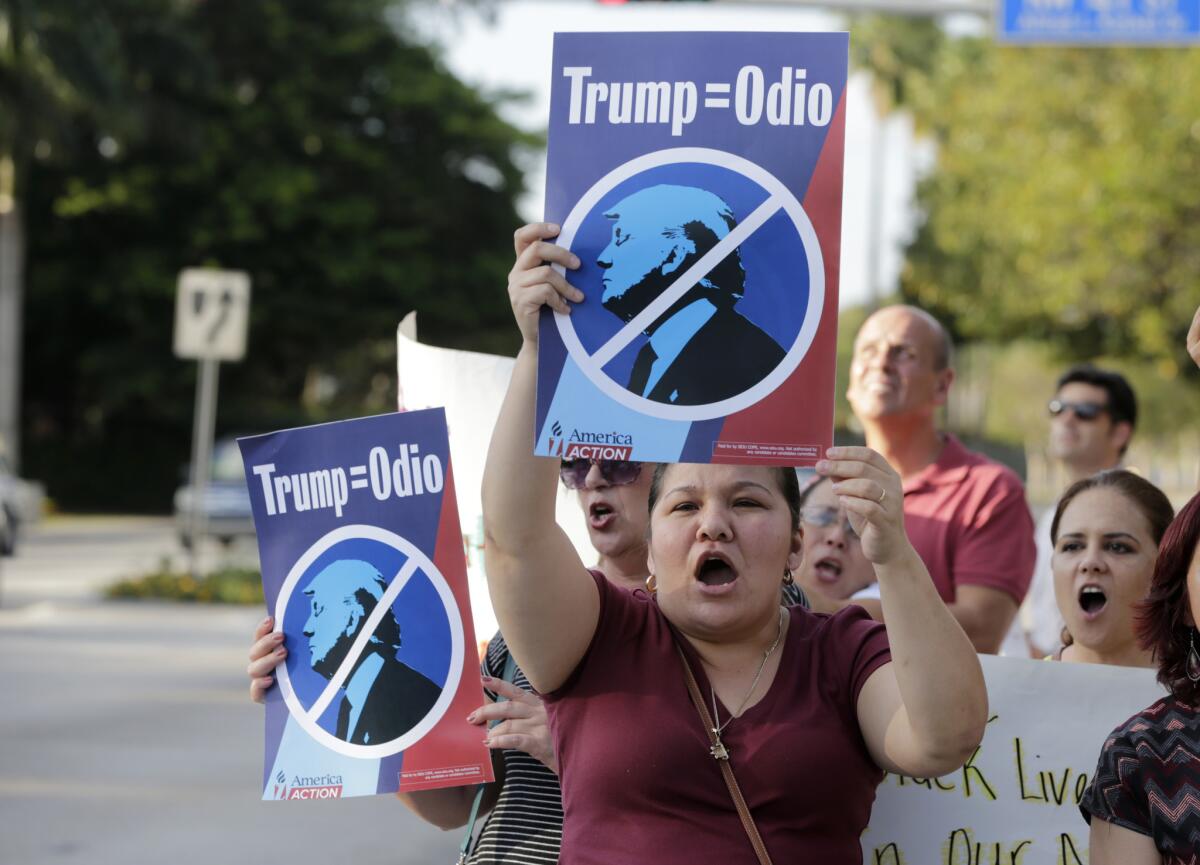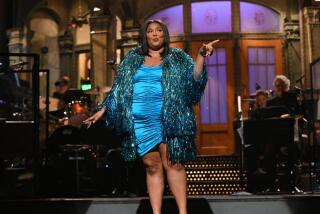Column: Whichever candidate gets elected come November should expect a miserable honeymoon

Berta Sandes, an undocumented immigrant from Nicaragua, holds a sign which translates to “Trump Equals Hate” during a protest against Republican presidential candidate Donald Trump on Monday, March 14, 2016, in Doral, Fla.
The presidential primaries are a long way from over, but they’ve already produced an unhappy paradox: Both parties appear headed toward nominating the two most unpopular candidates in the country.
Donald Trump, the Republican front-runner, has accomplished an unprecedented feat: More than two-thirds of voters say they can’t stand him. In the same unpopularity contest, Hillary Clinton, the likely Democratic nominee, is runner-up: more than half the voters don’t like her. Ted Cruz, who still has a shot at the GOP nomination, is almost as unpopular as Clinton.
In every major poll conducted since February, all three leading candidates are “underwater”: more voters view them unfavorably than favorably. The negative numbers are driven mostly by partisan animosity. Republicans are divided over Trump, and Democrats are divided over Clinton — but voters in each party are united in disliking the other sides’ front-runners by roughly 90% in each case.
67% of Democrats said they thought Trump would make a “terrible” president. Almost as many Republicans, 58%, said they thought Clinton would be terrible in the White House.
When the Pew Research Center asked voters how good a president each candidate would make, the results were striking: 67% of Democrats said they thought Trump would make a “terrible” president. Almost as many Republicans, 58%, said they thought Clinton would be terrible in the White House.
“We’ve never seen numbers like this before,” Carroll Doherty, Pew’s chief political pollster, told me.
And that has troubling implications for the next president, no matter who he or she turns out to be. After an election, presidents must bridge the partisan divide to get much done. But no need to wait for inauguration day 2017. We already know how this is going to turn out: We’re pre-polarized.
It’s easy to forget, but in 2009 Obama arrived at the White House with a massive 68% positive rating in the Gallup Poll, including 41% of Republicans. Eight years earlier, the newly elected George W. Bush enjoyed a 63% positive rating, including 37% of Democrats.
The honeymoon didn’t last, but the numbers meant that these presidents at least had the benefit of the doubt from most independent voters and a significant minority in the other party. They both had a base of popular support from which to negotiate with Congress. But that’s unlikely to happen this time.
With the next president already held in record low esteem, both parties will be tempted to follow the strategy example set by Senate Republican Leader Mitch McConnell during Obama’s presidency: constant confrontation, instead of bipartisanship, to heighten the chance of gaining ground in the next election.
“We worked very hard to keep our fingerprints off [Obama’s] proposals,” McConnell explained [to The Atlantic, in 2011]. “The only way the American people would know a great debate was going on was if the measures were not bipartisan.”
Most voters still tell pollsters they want Congress and the president to work together and get something done, of course. But that sentiment never seems to be powerful enough to overcome partisan distaste for the other side. Political scientists call this “affective polarization” — meaning the two sides just dislike each other more.
Whatever you call it, it produces the central political frustration of our time: political parties that see little reason to cooperate, and plenty of reasons to fight.
Is anyone pushing back?
Last week, a bipartisan group called “No Labels” unveiled a hopeful centrist program: a glossy catalog of sensible policy ideas, complete with poll numbers to show that each has wide public support.
Among the proposals: Allowing Medicare to negotiate with drug companies to lower prices, which gets 82% support. Passing a “no budget, no pay” law to withhold Congress’ paychecks if a federal budget isn’t passed, which gets 81% support. Increased funding for childcare and early education; 79% support.
The group has assembled a centrist “problem solver” caucus in Congress, with almost 80 members drawn equally from both the parties.
“We’re trying to disrupt the dysfunction,” said former Sen. Joseph I. Lieberman, the Connecticut Democrat who chairs the organization along with former Utah Gov. Jon Huntsman, a Republican.
“How do we encourage members of Congress and the next president to take these risks? Part of it is to say there is more support for these ideas than you think,” Lieberman said. “The next president has to ask: What’s my goal here? Do I just want to get reelected, or do I want to build a record?”
The group has a practical side, too. It’s raising money to protect centrist members of Congress from being knocked out of office in primary elections.
It’s a worthy effort. But the hill they are climbing looks steeper than ever — because in the presidential campaign each side is already demonizing the other. That will make it even more difficult for the next president to bring the two parties together after January 2017.
Twitter: @DoyleMcManus
Follow the Opinion section on Twitter @latimesopinion and Facebook
More to Read
A cure for the common opinion
Get thought-provoking perspectives with our weekly newsletter.
You may occasionally receive promotional content from the Los Angeles Times.







